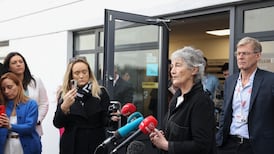Lord Gort rang his wife in England one afternoon in 1956 and said: "Bessy, I have bought two castles here in Ireland." Lady Gort called the family solicitor, Col John Gillman, and said to him: "I think Kerry has gone bonkers. He tells me he has bought - not one but two - castles in Ireland."One of these was Bunratty Castle, which has since been restored and has become one of the great success stories of Irish tourism.
This week Shannon Development celebrated the 40th year of the medieval banquets for which Bunratty has become famous. It is now the longest-running evening entertainment in Ireland and has been attended by more than four million people from all over the world.
The castle's medieval banqueting concept has now been copied by tourism promoters in many countries and the Shannon Castle Entertainers, as they are now called, travel abroad each year as tourism ambassadors for Ireland.
At one stage the development company, in its annual report, stated that, with the folk park, a later addition, it had become the biggest single tourist attraction in the country, with figures exceeding that of Killarney.
To mark the 40 years of operations, it was announced that Shannon Heritage, the development company's tourist subsidiary, is offering a limited number of banquets for a special price of €9.99 for two people and a commemorative bottle of mead on telephoning 061-360788.
It all began when Lord Gort's friend and adviser on such matters, John Hunt snr, sent him a cutting from The Irish Times which announced that Loch Cutra Castle near Gort was for sale. This had been the home of his family, the Verekers, after they left Limerick, until they sold it about 1840 and donated the proceeds to aid for famine victims in the district. Lord Gort was met on arrival at Shannon by Hunt but they were late for the auction. It had been bought for £20,000 by a man who was interested only in the lead on the roofing. Gort later sought him out and bought it back for £25,000.
On their way to Limerick, Hunt stopped at Bunratty, where he advised his friend to buy and restore the castle, which had been the stronghold of the O'Briens, kings and later earls of Thomond. Gort bought the ruined castle for £1,000 from Mr Richard Russell, who lived in the nearby Georgian house.
Lord Gort, who inherited his title from his brother, Field Marshal Viscount Gort VC, made his money in coal-mining and hotels in Winnipeg, Canada.
The castle was restored by Gort with the assistance of the Office of Public Works. Christy Lynch, a Clareman, who was special projects manager with the Shannon Sales and Catering Department, was appointed by Brendan O'Regan as the first manager of the castle and later the Folk Park. He paid a lavish tribute to the late Percy le Clerc, Inspector of National Monuments, who was in charge of the restoration work. "He did a superb job," he said.
John Hunt, who had been a consultant to Sothebys of London on medieval and early Celtic Art, became the honorary curator of Bunratty and travelled widely throughout Europe, especially Germany and France, to collect medieval furniture and contemporary artefacts. Gort, who had one of the finest collections of tapestries in the world, bequeathed them to the castle.
Bunratty was formally opened to visitors in 1960 by the then Minister for Transport and Power, Mr Erskine Childers. Mr Brendan O'Regan , who was head of Shannon Development and the catering service, was quick to see its tourist possibilities.
In July 1962 Ray Joyce joined SFADCo from American Express, Dublin when tourist amenities became a serious objective. The medieval banquets took off in April l963 to the sound of the fiddle and brightly costumed young ladies giving a rousing nightly opening chorus of the Jug of Punch.
Lord and Lady Gort occupied the Earl's bedroom, which is draped with damask and has a magnificent carved bed. This is similar to what was there in the fifth century for the Earl of Thomond. The Gorts loved the excitement of the banquet and frequently at night came onto the minstrel gallery over the great hall in their bedroom slippers to view the scene and listen to the music.
Childers opened the Folk Park, which was the brain child of Co Limerick man Kevin Danaher of the Irish Folklore Commission, in July 1964. It started off with two small farmhouses, a fisherman's house and a forge, where the few local farmers still using horses were glad of the opportunity of availing of the services of a genuine blacksmith. One of the farmhouses had been removed earlier to make way for the new jet runway. Later a variety of farmyard animals were introduced and the late Dean Mat Talbot of St Mary's Cathedral presented his great collection of farm machinery and utensils.
Christy Lynch says that before Lord Gort died, he set up a trust to ensure that the castle and its contents remained the property of the Irish people.









